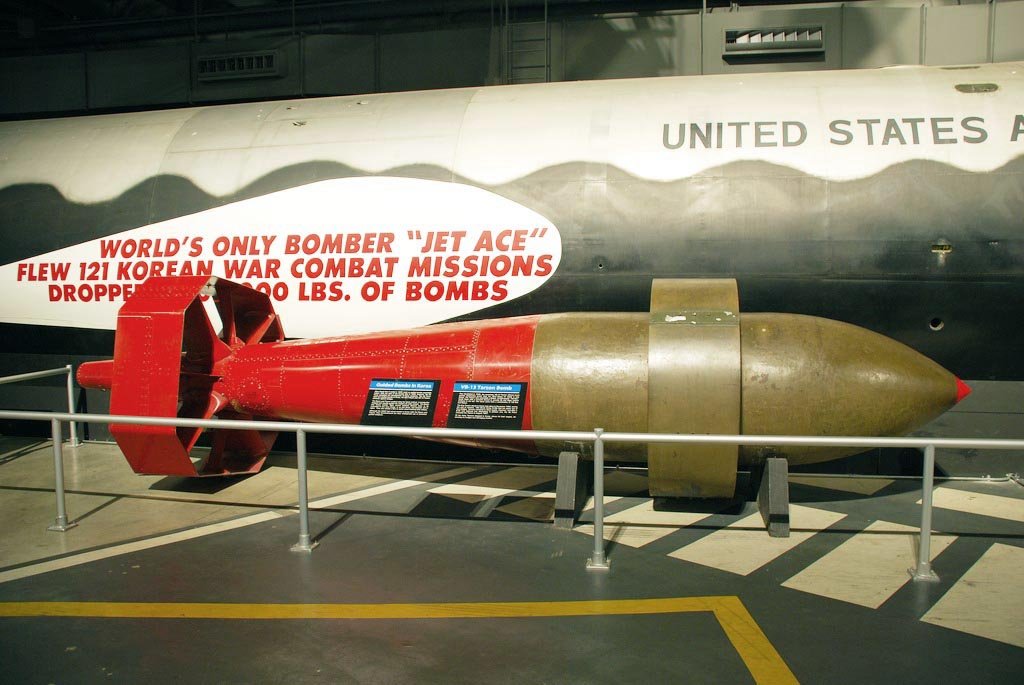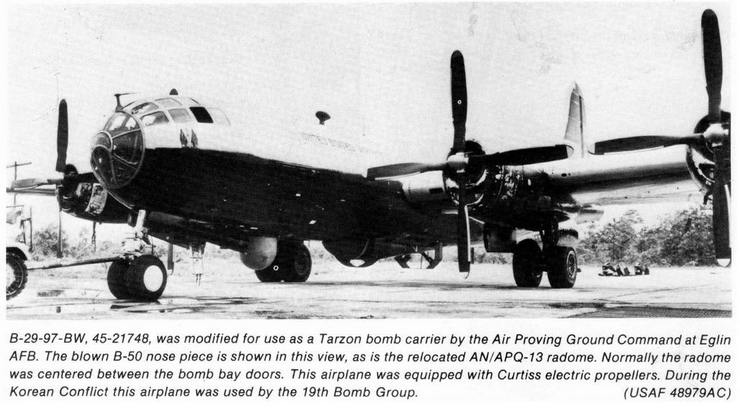- Yes
- No
(Note: This suggestion was imported over from the old WT forums.)
Hello. Today I would like to suggest the addition of the ASM-A-1 Tarzon guided bomb for B-29 Superfortress. This peculiar bomb is a modified version of the British Tallboy bomb into a radio-controlled guided bomb used during the early stage of the Korean war.
This is a follow-up suggestion of my earlier “Pumpkin bomb” for B-29, so please check it out as well.
The ASM-A-1 Tarzon next to a B-29 painted as “Command Decision”, one of the most famous B-29 during the Korean war.
The Tarzon (sometimes mislabelled as “Tarzan”) was first conceived in Febuary 1945 as a huge guided bomb to supplement and eventually replace the smaller VB-3 Razon guided bomb. The contract was awarded to Bell Aircraft, who repurposed the American-made T-10 bomb - itself a copy of the British “Tallboy” bomb - with the same radio guidance system of the Razon bomb.
The Tarzon was intended to be carried by a slightly modified B-29 Superfortress bombers, which only required the removal of its bomb bay doors and installing AN/ARW-38 command transmitter. The bomb was visually guided by the bombardier and aided by a flare at the tail. The guiding system is considered accurate, as it has an accuracy of within 85 meters during testing.
Other than guidance system, the Tarzon is largely similar to the Tallboy bomb it was based on, with the same filler of 2,400 kg of Torpex D1 explosives, though it is 500 kg heavier due to the addition of a guidance system.
Ground crews preparing the Tarzon on board the B-29.
Although development slowed down after the end of World War II, the Tarzon were pressed into the service during the Korean war. First used in December 1950, it was the largest bomb used in the war, the Tarzon were exclusively deployed by the 19th Bomber Group and were used against high-value targets. Initial missions were considered success, with 6 out of 28 bombs caused the destruction of key targets in North Korea, including an hydroelectric dam and a weapon factory. Because of this ,the USAF would have later placed an order of 1,000 bombs to be built.
However, the Tarzon’s career would met an abrupt end a few months later. Between March - April 1951, two Tarzons suffered a premature detonation on board due to a faulty arming wiring at the tail, resulting into the destruction of the aircraft that carried it. Although modifications were made to solve the problem, the damage was done; the bomb was deemed unsafe and can only be effectively deployed in clear day due to visual guidance. In addition, the advent of jet fighters and increased maintenance costs rendered the weapon unfeasible for further deployment. Thus, the Tarzon project were finally cancelled within the same year.
Specifications:
Length: 6.4 meters
Diameter: 0.97 meters
Total mass: 5,900 kg (13,000 lbs)
Filler: 2,400 kg (5,200 lbs) of Torpex D1
TNT equivalent: ~3,840 kg
Guidance: AN/URW-2 Radio-controlled pneumatic gyroscopes; MCLOS
Sources:
Dorr, Robert F. (2003). B-29 Superfortress Units of the Korean War. Osprey Combat Aircraft. Vol. 42. Oxford, England: Osprey Publishing. ISBN 1-84176-654-2.
Schmitt, Vernon R. (2002). Controlled Bombs and Guided Missiles of the World War II and Cold War Eras: An Inside Story of Research and Development Programs. Warrendale, PA: Society of Automotive Engineers. ISBN 0-7680-0913-8.
Steadfast and Courageous: FEAF Bomber Command and the Air War in Korea, 1950–1953. Air Force History and Museums Program. Washington, D.C.: Department of the Air Force. 2000. ISBN 978-0-16-050374-0
Gillespie, Paul G. (2006). Weapons of Choice: The Development of Precision Guided Munitions. Tuscaloosa, AL: University of Alabama Press. ISBN 978-0-8173-1532-0. Retrieved 2011-02-04.




